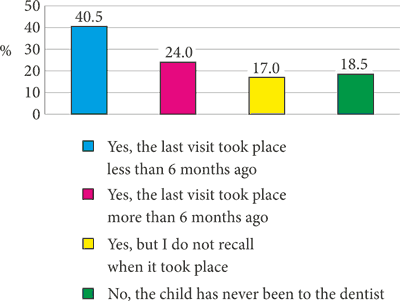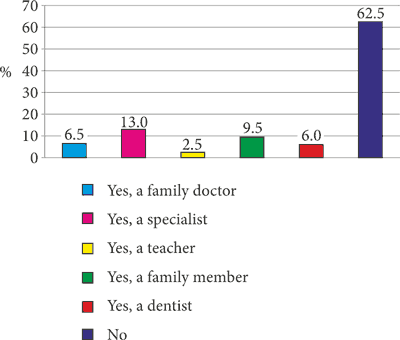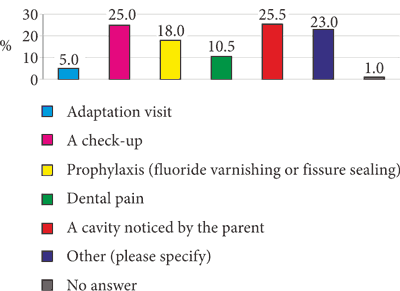Maria Borysewicz-Lewicka1, *Karolina Gerreth1, Dominika Wychowaniec1, Ewa Nitschke1, Anna Klimiuk2, Magdalena Choromańska2, Anna Zalewska2
Assessment of dental care in children with disability – a sociomedical study of parents/guardians
Ocena opieki stomatologicznej sprawowanej nad dziećmi z obniżoną sprawnością na podstawie badania socjomedycznego rodziców/opiekunów
1Paediatric Dentistry Clinic, Department of Paediatric Dentistry, Poznań University of Medical Sciences
Head of Department and Clinic: Professor Maria Borysewicz-Lewicka, MD, PhD
2Department of Conservative Dentistry, Medical University of Białystok
Head of Department: Professor Danuta Waszkiel, MD, PhD
Streszczenie
Wstęp. Opieka nad dzieckiem niepełnosprawnym związana jest z trudnościami występującymi w wielu dziedzinach życia, w tym także dotyczącymi zapewnienia dziecku kompleksowej opieki lekarskiej.
Cel pracy. Celem badania socjomedycznego była ocena poziomu opieki stomatologicznej sprawowanej nad dziećmi z obniżoną sprawnością na podstawie danych z kwestionariusza wypełnionego przez ich rodziców/opiekunów.
Materiał i metody. Badania przeprowadzone zostały wśród 200 rodziców/opiekunów dzieci niepełnosprawnych i/lub przewlekle chorych zamieszkujących na terenie Poznania i Białegostoku. Zebrano informacje dotyczące: częstotliwości wizyt stomatologicznych, ich przyczyn, możliwości dostępu do gabinetów dentystycznych oraz przebiegu leczenia, w szczególności odnoszącego się do zębów mlecznych. Przed przystąpieniem do badań uzyskano zgodę Komisji Bioetycznej przy Uniwersytecie Medycznym im. Karola Marcinkowskiego w Poznaniu (uchwała nr 159/17) oraz dyrektorów placówek i rodziców/opiekunów.
Wyniki. Uzyskane dane pokazały, że aż 18,50% dzieci z obniżoną sprawnością nie było nigdy u lekarza dentysty. W najwyższym odsetku powodem wizyty dentystycznej były zauważone przez rodzica zmiany w zębie dziecka (25,50%) lub badanie kontrolne (25,00%). U 36 dzieci (18,00%) kilkukrotnie występowały odzębowe dolegliwości bólowe, przy czym 47,00% dzieci nigdy nie miało leczonych zębów mlecznych. Barier w dostępie do leczenia stomatologicznego nie zgłosiło 67,50% respondentów. Aż 51,50% rodziców/opiekunów podało, iż aktualnie nie ma potrzeby leczenia uzębienia u ich dzieci.
Wnioski. Zaprezentowane dane obrazują brak dostatecznej opieki dentystycznej nad dziećmi z obniżoną sprawnością, co zapewne wynika głównie z niedostatecznej edukacji ich opiekunów/rodziców w zakresie dbania o zdrowie jamy ustnej ich podopiecznych. Wyniki badań wskazują również na wciąż występujący problem napotykania na trudności w dostępie do leczenia stomatologicznego, takie jak bariery architektoniczne i finansowe czy w dostępności do opieki stomatologicznej w miejscu zamieszkania.
Summary
Introduction. The care of a child with a disability is associated with difficulties in many areas of life, including comprehensive medical care.
Aim. The aim of the sociomedical study was to assess the level of dental care provided to children with disability based on the data from a questionnaire study performed in their parents/guardians.
Material and methods. The research was conducted among 200 parents/guardians of disabled and/or chronically ill children living in Poznań and Białystok. Information on the frequency of dental visits and their causes, access to dental offices as well as the course of treatment, particularly in primary teeth, was collected. The study was approved by the Committee of Bioethics of the Poznan University of Medical Sciences (Resolution No. 159/17) as well as the directors of institutions and parents/guardians.
Results. The data obtained showed that up to 18.50% of children with disability had never been to a dentist. The most common reasons for a dental visit were changes within a tooth noticed by a parent (25.50%) or a dental check-up (25.00%). Thirty-six children (18.00%) experienced a few episodes of dental pain, whereas 47.00% of children had never received dental treatment of primary teeth. Only 67.50% of respondents reported no access barriers to dental treatment. Up to 51.50% of parents/guardians reported that there was currently no need for dental treatment in their children.
Conclusions. The data presented show that there is insufficient dental care for children with disability, which is probably due to inadequate education of their parents/guardians, in relation to the care of oral health in children. The study also indicates the presence of obstacles in access to dental treatment, such as architectural or financial barriers as well as problems in access to dental care in the place of residence.

Introduction
Children and adolescents with disabilities are a group of patients requiring special attention and commitment from both parents/guardians and medical personnel. Due to the limited independence resulting from motor and intellectual disorders, they need much more supervision and support in all life activities, including those regarding oral health (1).
The special needs of children with disability include the need for appropriate dental care, easy access (location close to the place of residence) to specialist care and a short waiting time for an appointment. Additionally, it is important to adjust the architecture of a dental office and dental setting to the needs of patients with disabilities as well as to appropriately equip dental offices in order to facilitate efficient and comprehensive dental care (2).
Dental caries and gingival inflammation are the most common dental problems affecting children with disabilities. These are mainly due to the difficulties in maintaining proper oral hygiene as a result of the lack of daily assistance in this area (3, 4). Other important factors that contribute to the development of oral conditions in this group of paediatric patients include malocclusions, which are more common in these children compared to their healthy peers, oral breathing, cariogenic diet and chronic systemic treatment (5). Furthermore, patients with disability experience mechanical injuries of the teeth and oral mucosa that require dental treatment more often compared to healthy population (6).
Aim
The aim of the paper was to assess dental care in children with disabilities based on a questionnaire among their parents/guardians.
Material and methods
The study was conducted in 2017 in two Polish cities, i.e. in Poznań, which is located in the western part of the country (Greater Poland Voivodeship), and Białystok, which is located in the north-eastern Poland (Podlasie Voivodship), as a part of a project entitled “Education, Promotion and Prevention in Regards to Oral Health Care Directed toward Small Children, Their Parents, Carers and Educators”, which is also known under the name “Caries-Free Childhood” (7-9). The project was co-funded by Switzerland as a part of Swiss cooperation programme with new EU member states as well as the by the Ministry of Health.
The sociomedical research was conducted among parents/guardians of disabled and/or chronically ill patients aged between 3 and 17 years, who attended educational institutions (preschools and schools) and associations as well as patients staying in physical therapy wards.
The study was approved by the Committee of Bioethics of the Poznan University of Medical Sciences (Resolution No. 159/17) as well as the directors of institutions and parents/guardians.
The questionnaire for parents/guardians of children with disabilities contained single and multiple choice questions regarding, among other things, dental care provided to children, including access to dental treatment, referring to dental visits, reasons for dental appointments and the course of treatment.
Since not all parents answered the questions, the final analysis included data from 200 respondents.
Results
Of the 200 parents/guardians included in the questionnaire study, 37 (18.50%) reported that their child had never been to a dentist. Other respondents declared that they had already reported to a dental office in order to ensure dental care for their child, including 81 parents/guardians (40.50%) reporting that the visit took place in the last 6 months. A total of 34 respondents (17.00%) did not remember the time of the last dental visit (fig. 1).

Fig. 1. Answers to a question: “Has your child ever been at the dentist’s before and when was the last visit?”
Referral to dental treatment was issued by a family doctor in 13 children (6.50%), by a specialist in 26 children (13.00%), by a dentist in 12 children (6.00%), or suggested by a family member in 19 children (9.50%). Up to 125 of 200 respondents (62.50%) declared that their child had never been referred by anyone for dental treatment (fig. 2).

Fig. 2. Answers to a question: “Has anyone ever referred your child for dental treatment and who was it?”
The reasons for child’s dental visit included dental pain (21 respondents, 10.50%), a cavity noticed by parents/guardians (51, 25.50%) or a planned preventive procedure, such as fluoride varnishing or fissure sealing (36, 18.00%). Only 10 respondents (5.00%) took their child for an adaptation visit, while a check-up visit was reported by 50 parents/guardians (25.00%). Other causes included tooth extraction, orthodontic treatment or dental tartar removal, as well as the occurrence of disturbing green-brown discolouration of erupted teeth and problems with articulation. The presence of a tuberous sclerosis was reported as reason for dental appointment in one case (fig. 3).

Fig. 3. Answers to a question: “What was the reason for the visit?”
Powyżej zamieściliśmy fragment artykułu, do którego możesz uzyskać pełny dostęp.
Mam kod dostępu
- Aby uzyskać płatny dostęp do pełnej treści powyższego artykułu albo wszystkich artykułów (w zależności od wybranej opcji), należy wprowadzić kod.
- Wprowadzając kod, akceptują Państwo treść Regulaminu oraz potwierdzają zapoznanie się z nim.
- Aby kupić kod proszę skorzystać z jednej z poniższych opcji.
Opcja #1
29 zł
Wybieram
- dostęp do tego artykułu
- dostęp na 7 dni
uzyskany kod musi być wprowadzony na stronie artykułu, do którego został wykupiony
Opcja #2
69 zł
Wybieram
- dostęp do tego i pozostałych ponad 7000 artykułów
- dostęp na 30 dni
- najpopularniejsza opcja
Opcja #3
129 zł
Wybieram
- dostęp do tego i pozostałych ponad 7000 artykułów
- dostęp na 90 dni
- oszczędzasz 78 zł
Piśmiennictwo
1. Dièguez-Pèrez M, de Nova-Garcia MJ, Mourelle-Martínez MR, Bartolomè-Villar B: Oral health in children with physical (Celebral Palsy) and intellectual (Down Syndrome) disabilities: systematic review I. J Clin Exp Dent 2016; 8(3): 337-343.
2. Gerreth K: Sprzęt wykorzystywany podczas leczenia stomatologicznego pacjentów niepełnosprawnych i przewlekle chorych – przegląd piśmiennictwa. Mag Stomatol 2013; 23(2): 158-162.
3. Morgan JP, Minihan PM, Stark PC et al.: The oral health status of 4,732 adults with intellectual and developmental disabilities. J Am Dent Assoc 2012; 143(8): 838-846.
4. Gerreth K: Sposoby utrzymywania higieny jamy ustnej u pacjentów niepełnosprawnych i przewlekle chorych – na podstawie piśmiennictwa. Prz Lek 2013; 70(1): 31-34.
5. Pini DM, Fröhlich PC, Rigo L: Oral health evaluation in special needs individuals. Einstein 2016; 14(4): 501-507.
6. Batista C, Ramos-Jorge ML, Coelho M et al.: Dental trauma in individuals with severe cerebral palsy: prevalence and associated factors. Braz Oral Res 2011; 25: 319-323.
7. Borysewicz-Lewicka M, Gerreth K: Działania populacyjne w zapobieganiu chorobie próchnicowej zębów. Stomatol Współcz 2016; 23(3): 36-39.
8. Borysewicz-Lewicka M, Gerreth K, Gmerek P: Program stomatologicznej edukacji prozdrowotnej w ramach projektu „Edukacja, promocja i profilaktyka w kierunku zdrowia jamy ustnej skierowana do małych dzieci, ich rodziców, opiekunów i wychowawców”. Stomatol Współcz 2015; 22(4): 26-29.
9. Borysewicz-Lewicka M, Gerreth K, Gmerek P: Promowanie zdrowia jamy ustnej dzieci przedszkolnych – materiały edukacyjne. Dental Forum 2015; 43(2): 99-102.
10. Borysewicz-Lewicka M, Wochna-Sobańska M, Mielnik-Błaszczak M et al.: Ocena stomatologicznych zachowań prozdrowotnych dzieci i młodzieży niepełnosprawnej z wybranych województw Polski – badania socjomedyczne. Czas Stomatol 2010; 63(1): 18-26.
11. Borysewicz-Lewicka M, Wochna-Sobańska M, Mielnik-Błaszczak M et al.: Wyniki ekspertyzy oceniającej stan jamy ustnej, potrzeby lecznicze, a także dostępność do stomatologa dzieci oraz młodzieży niepełnosprawnej i przewlekle chorej. Czas Stomatol 2010; 63(2): 90-101.
12. Borysewicz-Lewicka M, Gerreth K, Wiśniewska K, Wysocki J: Leczenie stomatologiczne jako część wymaganej opieki medycznej nad dziećmi niepełnosprawnymi – opinia rodziców. Dent Med Probl 2011; 48(1): 45-53.
13. Leroy R, Declerck D: Oral health care utilization in children with disabilities. Clin Oral Invest 2013; 17: 1855-1861.
14. Grzesiak-Gasek I, Kaczmarek U: Wiedza rodziców na temat zdrowia jamy ustnej w odniesieniu do intensywności próchnicy u ich dzieci w wieku 6-7 lat. Dent Med Probl 2015; 52(2): 184-191.
15. Hilton IV, Stephen S, Barker JC, Weintraub JA: Cultural factors and children’s oral health care: a qualitative study of carers of young children. Community Dent Oral Epidemiol 2007; 35(6): 429-438.
16. Galeotti A, Garret Bernardin A, D’Antò V et al.: Inhalation Conscious Sedation with Nitrous Oxide and Oxygen as Alternative to General Anesthesia in Precooperative, Fearful, and Disabled Pediatric Dental Patients: A Large Survey on 688 Working Sessions. Biomed Res Int 2016; 2016: 7289310.
17. Bartolomè-Villar B, Murelle-Martínez MR, Dièguez-Pèrez M, e Nova-Garcia MJ: Incidence of oral health in paediatric patients with disabilities: sensory disorders and autism spectrum disorder. Systematic review II. J Clin Exp Dent 2016; 8(3): 344-351.



